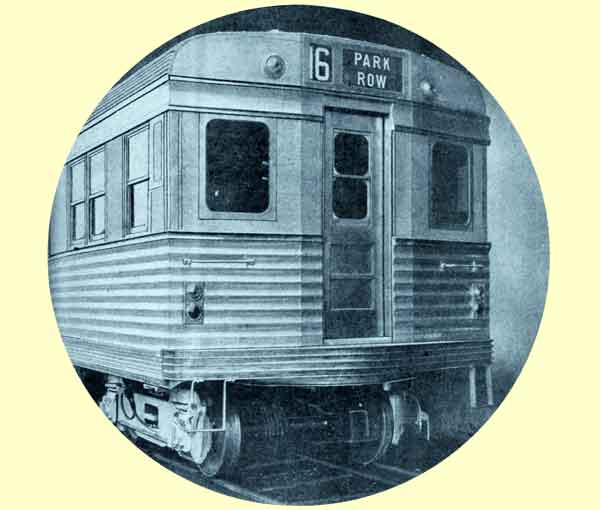|
Back to the Future—
New York's Lost Transit
Legacy Page
1
A newcomer to the Big
Apple
rarely arrives unaware of the vastness of the New York City subway
system.
After using the system for a while,
one begins to notice differences between parts of the system. Some are
newer or older than others and, if you venture far enough from Midtown,
the “subway” pops out of the underground to ride on elevated structures,
in open cuts or earthen embankments or even, in a few spots, on the
surface.
But even those who don’t travel far
realize that some subway lines are designated by letters, while others
bear numbers. The neophyte paying attention soon notices that the trains
on the lettered lines are longer and wider than those on the numbered
lines.
BMT, IND, IRT
This is our introduction
to the subways’ rich and varied past, for the lettered lines and the
numbered lines were built by and for different entities. The numbered
lines (1 through 9, with “8” currently unused) trace their origin to the
Interborough Rapid Transit Company, or IRT. The lettered lines, running
from A to Z with a number of gaps, reflect the existence of two very
different operators, the Brooklyn-Manhattan Transit Corporation, or BMT,
and the city-owned and operated Independent System. This latter
organization went by various names and acronyms, but finally matched the
other systems’ three-letter designations as the
IND.
Since June of 1940 all three systems have
been owned by the City of New York and operated first by the City’s Board
of Transportation and since 1953 by the New York City Transit Authority.
The NYCTA (now popularly but not legally shortened to NYCT by dropping the
bureaucratic “Authority”) is itself part of the regional Metropolitan
Transportation Authority, though this super-agency is surprisingly
invisible in daily operations.
Three Operators, Three Cultures
The
cultures of the three original operators—the way they conducted their
businesses and viewed their futures—was radically different and reflected
their diverse origins.
The IRT was New York’s first successful subway
operator, contracting with the City to operate the famous first subway
line from City Hall up the East Side to 42nd Street, across
town on the current shuttle tracks, then up Broadway to upper Manhattan
and the Bronx. There was no IRT without those City-financed subways. The
IRT hoped to be the City’s only
subway operator, and attempted to block potential competition by fair
means and foul. At the very beginning of the 20th
Century that translated to using political and business influence and that
perennial favorite, simply buying up the competition. That latter method
brought the company to grief years later.
The
BMT’s linear predecessor, the Brooklyn Rapid Transit Company or BRT, had a
much different origin. The BRT was created in 1896 to buy or lease the
motley assemblage of privately owned and operated elevated, steam railroad
and street railway lines running in Kings County and mold them into a
viable consolidated system. An observation attributed to James Blaine
Walker was that Brooklyn was divided into three parts, Brooklyn (the old
city), South Brooklyn (Red Hook) and “the suburbs.” This last was most of
Kings County—modern Brooklyn, including the vast crescent from Bay Ridge
through Flatbush, Flatlands and Canarsie to the Queens border, from the
southern edges of Prospect Park to the sea. The BRT’s proprietary view of
its place in Brooklyn life was reflected in the further view that
“Dutchmen discovered Brooklyn, Englishmen discovered South Brooklyn, and
the suburbs were discovered by the Brooklyn Rapid Transit Company or its
predecessors.”
Continued on page 2

The
Budd-built Zephyr arrived in the midst of The Great
Depression in 1934, one of the BMT's first two candidates
to modernize its elevated fleet. It lived out most of its service
life on that home of oddball and orphaned equipment, the Franklin Avenue
Shuttle. Paul Matus Collection from the
BMT Monthly
The Third Rail and The Third Rail
logo are trademarks of The Composing Stack
Inc.
|

